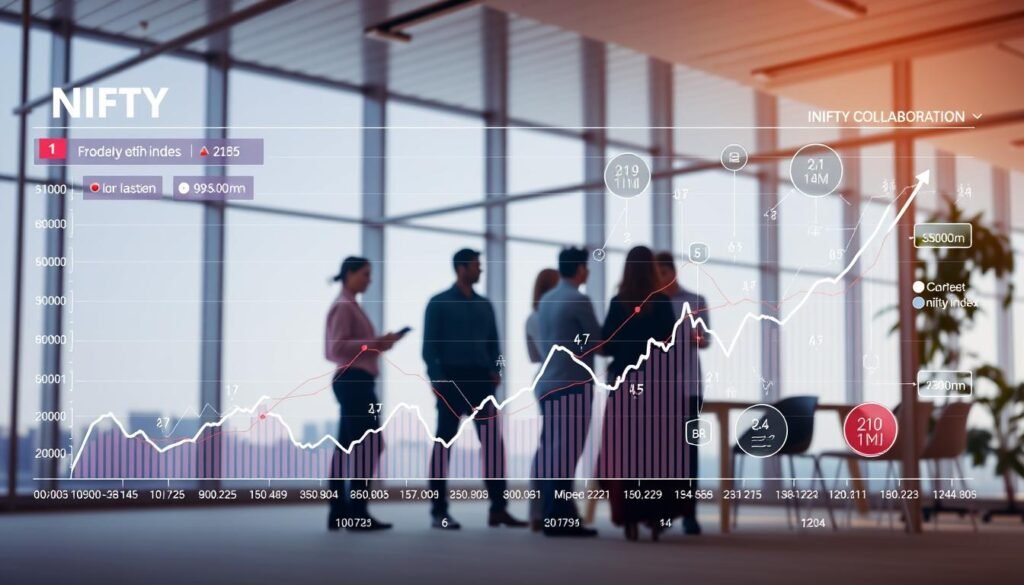What if the same principles that drive the stock exchange could supercharge your team’s productivity? The NIFTY 50, India’s leading market index, tracks top-performing stocks across 13 sectors—but its strategies can also revolutionize project management.
Just as the NIFTY 50 prioritizes high-impact companies (representing 60%+ of the NSE’s free-float market cap), teams can focus on key contributors. Semi-annual rebalancing mirrors agile adjustments in workflows, while its current value of 25,405.30 INR proves measurable success.
Key Takeaways
- Stock market strategies can optimize team collaboration.
- Track top performers like high-value stocks for productivity.
- Rebalance team roles periodically for peak efficiency.
- Focus on key contributors to drive project success.
- Use measurable metrics to track progress.
What Is Nifty? Understanding the Index and Its Collaborative Parallels
The Nifty 50 index, India’s premier stock benchmark, offers insights beyond finance. Launched in 1996 with a base value of 1,000, it tracks top-performing companies on the national stock exchange. Like a high-performing team, its evolution reflects strategic adjustments—most notably adopting the free-float methodology in 2009 to prioritize liquid stocks.

The Origins and Purpose of Nifty 50
Originally designed to represent India’s economic diversity, the index now spans 13 sectors, from IT to energy. This mirrors cross-functional teams, where varied expertise drives collective success. For example, Reliance Industries—with its 239.95B INR market capitalization—exemplifies how leadership roles anchor performance, much like key contributors in projects.
How Tracking Top Performers Applies to Team Management
The national stock exchange rebalances the Nifty 50 every six months, a practice teams can adopt for talent reviews. Bharti Airtel’s 41.41% annual gain demonstrates the value of tracking high-impact metrics. Similarly, teams thrive when they identify and reward top performers, ensuring agility in dynamic environments.
Key Components of Nifty 50: Lessons for Team Structure
High-impact stocks in the Nifty 50 reveal strategies for structuring winning teams. Like the index, teams thrive when roles align with core strengths and sector expertise.

Top Holdings and Their Roles
HDFC Bank, TCS, and Infosys anchor the Nifty 50—just as key contributors stabilize projects. These companies represent 32.76% of the index’s financial services sector, mirroring how teams rely on core departments.
Bajaj Finance’s 17.95% annual return shows specialized skills drive growth. Similarly, niche experts in teams—like IT members (13.76% of the index)—deliver outsized impact.
Sector Diversification: Mirroring Multidisciplinary Teams
The Nifty 50 balances stability (Hindustan Unilever) with growth (stocks like Adani Enterprises). Teams need this mix: steady performers and innovators.
Consumer goods (consumer goods sector: 8.46%) and IT sectors reflect diverse skills. Rebalancing every six months ensures alignment—just like talent reviews keep teams agile.
Free-float market caps prioritize liquid assets. Teams should similarly spotlight high-impact members, adapting as priorities shift.
How Nifty 50’s Methodology Can Streamline Your Team
Teams can adopt the Nifty 50’s rigorous methodology to enhance efficiency. Its data-driven strategies—like prioritizing liquid assets and regular reviews—translate seamlessly to team management. By mirroring the index’s disciplined approach, leaders can optimize resource allocation and adapt to shifting priorities.
Free-Float Market Cap: Prioritizing High-Impact Contributors
The Nifty 50’s free float model excludes locked-in shares, focusing only on tradable stocks. Similarly, teams should assess actual availability, not just theoretical capacity. For example, a member’s market capitalization—their measurable impact—matters more than their title.

IndusInd Bank’s 40.07% drop highlights the cost of overlooking underperformers. Apply the index’s 0.50% impact cost threshold: identify and address bottlenecks before they disrupt workflow. This ensures 90% of your team’s energy fuels high-value tasks.
Semi-Annual Rebalancing: Adapting to Changing Priorities
Every six months, the Nifty 50 reevaluates its components based on performance and liquidity. Teams benefit from similar cycles—review roles quarterly, using the index’s 4-week notice period for smooth transitions.
The 100M INR basket size requirement mirrors smart resource allocation. Assign projects based on proven capacity, not guesswork. Track trade metrics like deliverables per sprint to stay agile.
Nifty’s Performance Metrics: Measuring Team Success
Performance tracking isn’t just for markets—it’s a game-changer for team productivity. Just as the Nifty 50 monitors key performance points, teams can use data to refine workflows and boost efficiency.

Historical Highs and Lows: Learning from Trends
The index’s 24-hour -0.19% change mirrors daily team adjustments. Small dips, like a missed deadline, require quick fixes to extract maximum value. A +2.50% monthly gain, however, shows steady progress—ideal for sprint retrospectives.
Crises teach resilience. The Nifty’s 12.98% single-day drop during COVID-19 parallels sudden project roadblocks. Teams that adapt to today’s challenges, like the index’s 75.76% 2009 rebound, emerge stronger.
Annual Returns: Setting Realistic Team Goals
A 4.58% yearly gain sets a baseline for OKRs. Compare this to the 2024 election’s 5.93% drop—a lesson in managing external disruptions. Teams should balance ambition with the value of agility.
At 26,277.35 INR, the Nifty’s all-time high underscores the power of consistency. Track critical data points: deliverables, feedback cycles, and role adjustments. Like the index, teams thrive when metrics guide decisions.
Nifty Derivatives: Flexible Tools for Dynamic Collaboration
Financial derivatives aren’t just for traders—they offer powerful frameworks for agile teamwork. Just as markets use futures and options to hedge risks, teams can adopt these tools to navigate project uncertainties. The $7B daily volume of GIFT Nifty proves their scalability for cross-border workflows.
Futures and Options: Agile Project Adjustments
Futures contracts mirror contingency planning. Lock in deliverables like trade agreements, with weekly expirations acting as sprint deadlines. For example, the discontinued Nifty Bank weekly options model shows how to pivot when priorities shift.
March 2020’s $2.2T stimulus response demonstrates budget reallocation under pressure. Teams can replicate this by adjusting resource levels during crises, much like investors rebalance portfolios.
GIFT Nifty: Cross-Border Team Synergies
The SGX-to-GIFT Nifty transition (July 2023) exemplifies seamless global integration. Distributed teams can adopt NSEIX’s framework, aligning time zones and workflows. High liquidity in these markets reflects the need for real-time collaboration tools.
Nifty Next 50: Building a Pipeline for Team Growth
Building a talent pipeline is as critical for teams as it is for stock indices like Nifty Next 50. This index tracks rising companies poised to join the Nifty 50, offering lessons in spotting and nurturing high-potential contributors.
Identifying Emerging Talent in Your Team
Like Jio Financial’s March 2025 inclusion in the list, teams should model succession planning. Track metrics such as skill growth and project impact—similar to how Bharat Electronics’ September 2024 promotion reflected its 12.12% sector weight.
Set probationary periods mirroring the index’s 1-month listing minimum. This ensures new hires or internal candidates prove their value before taking on critical roles.
Preparing for Future Leadership Transitions
Adopt the Nifty Next 50’s 6-month evaluation cycle for leadership reviews. Like Adani Ports’ 2015 inclusion, internal mobility programs should prioritize adaptability and proven results.
Allocate funds for development, just as investors analyze a stock’s price trajectory. This prepares teams for seamless transitions during growth phases or unexpected changes.
Risks and Rewards: Balancing Stability and Innovation
Stability and innovation often pull teams in opposite directions—just like in trading. The Nifty 50’s 17.74% single-day gains (May 2009) versus its 8.30% COVID crash (March 2020) reveal how volatility demands agility. Teams must weigh risks against rewards to thrive.
Market Volatility: Navigating Team Conflicts
Apply lessons from the 2008 subprime crisis to conflict resolution. When tensions spike, reassign roles like the index rebalances sectors. Track key points: communication gaps, workload imbalances, or missed deadlines.
Natural gas markets swing fast—so do team dynamics. Address conflicts early, mirroring the Nifty’s 51.79% drop analysis. Contingency plans keep projects on track during upheavals.
High-Reward Stocks: Encouraging Bold Initiatives
Corporate tax cuts drove 6.12% gains in September 2019—set similar ROI benchmarks for innovation. UltraTech Cement’s 12,398 INR/share high-risk model inspires prototype testing.
Balance roles like HDFC Life’s stability with Titan’s growth potential. Moving consumer goods teams, for example, need both steady performers and disruptors. Use a website dashboard to track bold moves and their impacts.
Conclusion: Leveraging Nifty Principles for Collaborative Success
The Nifty 50’s 8.80% 2024 return proves its model works—for markets and teams. Diversify roles like the index balances sectors, blending stability with innovation. Regular reviews keep workflows agile, just as corporate tax cuts boosted responsiveness.
Scale collaboration like GIFT Nifty’s $7B daily trade volume. Focus resources on high-impact areas, mirroring the 60% market cap rule. Build talent pipelines with the Nifty Next 50’s growth mindset.
Apply these strategies to your team. Track performance, adapt quickly, and prioritize top contributors. The stock exchange’s discipline drives success—yours can too.
FAQ
What is the Nifty 50 index?
The Nifty 50 is a benchmark stock market index tracking the performance of 50 large-cap companies listed on the National Stock Exchange of India. It reflects economic trends and sector strengths.
How often is the Nifty 50 rebalanced?
The index undergoes semi-annual reviews in March and September. Adjustments ensure it stays relevant by adding high-performing stocks and removing underperformers.
What sectors dominate the Nifty 50?
Financial services, IT, and fast-moving consumer goods (FMCG) hold significant weight. Diversification across sectors helps balance risk and mirrors effective team structures.
How does free-float market capitalization impact the index?
Free-float methodology weights companies by their publicly traded shares, emphasizing liquidity. This approach prioritizes high-impact contributors—similar to valuing key team members.
What is GIFT Nifty?
GIFT Nifty allows trading the index futures from Gujarat International Finance Tec-City. It bridges global markets, much like cross-border team collaboration tools.
Why track the Nifty Next 50?
This index highlights emerging mid-cap companies, serving as a talent pipeline. Teams can apply this by identifying and nurturing future leaders internally.
How do derivatives like futures and options relate to project management?
Just as derivatives hedge market risks, agile methodologies let teams adjust project scopes dynamically to meet changing priorities.
What lessons can teams learn from Nifty’s volatility?
Market fluctuations teach resilience. Teams can adopt flexible strategies to navigate conflicts while maintaining long-term goals.
